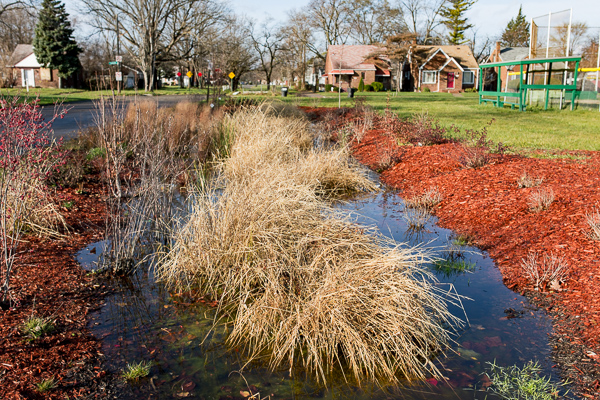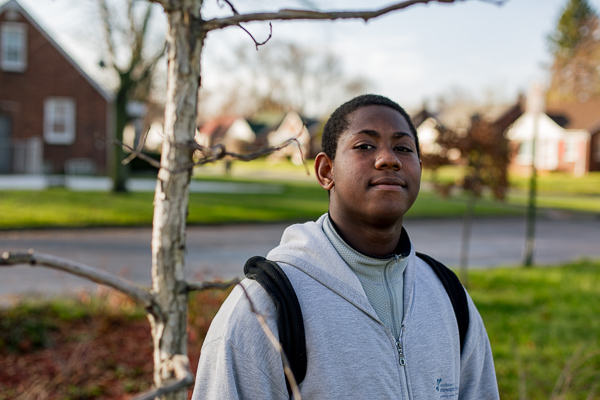Detroit high school students learn how to build green infrastructure in Cody Rouge's Stein Park
Brian Allnutt |
Tuesday, December 20, 2016
Northwest Detroit's Stein Park seems to embody much of the history, hopes, challenges and potential of the Cody-Rouge area. Maybe that's because it occupies a space that was once farmland, where a creek flowed into the Rouge River. That creek is now buried beneath playfields and trees, a memory of the way the landscape has been altered.
According to Detroit Institute of Technology teacher Chad Segrist, natural features like creeks might have helped this neighborhood, which was especially hard hit by flooding during the record rain storms in 2014. But in this concrete and pavement filled neighborhood, people like Segrist, Dean Hay from the Greening of Detroit, Rodney Gassaway from
Joy-Southfield Community Development Corporation, and Segrist's Green Team at the DIT are working on new strategies to deal with rainfall and flooding while also creating opportunities for community advancement.
Gassaway, a pastor and head of community and economic development at Joy-Southfield CDC, says his organization is trying to make a "green zone or eco-district." This goal was driven by research which found that green manufacturing jobs pay more than other comparable jobs, and that management positions often only require an associate's degree.
Other community concerns also played into the decision to create an eco-district.
"The number one thing the community said they wanted was safety," he says. "If you have an area that looks nice and you attract businesses, then the more people you have in that area, the more busy it is, the less crime there is. Second of all, they wanted good schools."
Gassaway hopes that green infrastructure projects like the bioswale at Stein Park and similar rainwater catchment systems along Joy Road will provide beauty and a sense of community investment that will help drive business development in the area.
The bioswale is designed to capture water from roadways and infiltrate it into the ground with the help of bowl-shaped landscapes, porous soils, and a variety of attractive native plants that include things like black-eyed-Susans, oak trees, and viburnums. They reduce the pressure on the city's combined sewer system, preventing flooding and the release of sewage into local waterways that occurs when the system is overloaded.
The project at Stein Park also aims to educate by engaging the Green Team at the Detroit Institute of Technology high school, which is adjacent to the park.
 Bioswale at Cody Rouge Park
Bioswale at Cody Rouge Park
"We brought the design to them and said here's what we're thinking, how would you improve on it," says Dean Hay director of green infrastructure and principal landscape designer at the Greening of Detroit. "And there were some pretty off the wall, unconventional thoughts, but overall they started to learn about the engineering part and the landscape architecture part of how stormwater is collected, stored, and infiltrated."
This process included teaching students how to use Google SketchUp software to do design as well as hands-on work installing of the bioswale in the park. Segrist, who worked with the Green Team for several years think,s that this has been a transformative experience for the students.
"They've become more vocal," he says. "The group has spoken at My Brother’s Keeper, the president's initiative to engage more young men, and in our case women, in empowerment and what their voice can mean."
They've also helped to bring the message of green infrastructure and green development to their own community via the Cody Youth Ambassador program.
"It's about having a sense of place," Segrist says, "appreciating and understanding what your environmental work could mean to the community, and how that can help bring not only empowerment but also a sense of pride."
DaVaughn Smith is a 10th-grade member of the Green Team and aspiring chemical engineer.
"When most people see it, they try to keep it cleaner," says Smith. "I see people say, 'Hey look, do you see what they're doing for this park? Don't just throw your trash everywhere, throw it away.'"
 DaVaughn Smith, 10th-grader and member of the Green Team
DaVaughn Smith, 10th-grader and member of the Green Team
The efforts of the Green Team and other programs could also foster economic empowerment by preparing students for important jobs in the community and beyond.
"We're at a nexus right now," says Hay, "in that many of the federal government agencies have acknowledged that they need to reach inner-city youth and have a stronger minority representation in their ranks. We are starting to see that the National Park Service, U.S. Fish and Wildlife and U.S. Forest Service. Those agencies are coming to Detroit to test new programs that will help inner-city youth understand, embrace, and choose natural resource careers so that they can go into these agencies and represent their communities."
Right now, the bioswale only takes up a small area on the south side of the park near Cathedral Street, but according to Gassaway, plans are afoot for more green infrastructure in the park including additional bioswales and a 120-space parking lot next to the football field to be built with pervious pavers that could pull all of the park's runoff away from the combined sewer system.
Segrist says the park has come a long way. "When I first started at the high school, Stein Park was a pit in all honesty," he says.
This was several years ago, when high school football games weren't played in the park and the pavement was dotted with cracks and potholes. Over the years, the nonprofit Life Remodeled helped to rebuild the football field and numerous other corporations and nonprofits contributed to park improvements.
Segrist's goal for the park and the school is being realized. "We wanted to be the beacon of hope in the community and its revitalization," he says.
More immediately, there are the simple joys of seeing people learn and enjoy themselves. Segrist says his favorite part of working with the Green Team was, "To see them laugh openly and honestly with each other and have a good time while they’re doing environmental work. That's gratifying for me."
This story is part of a series on measuring on the role of green infrastructure projects in Detroit's redevelopment. Support for this series is provided by the Erb Family Foundation to Greening of Detroit, Model D, and The Nature Conservancy. Read more articles from the series here.
All photos by Nick Hagen.